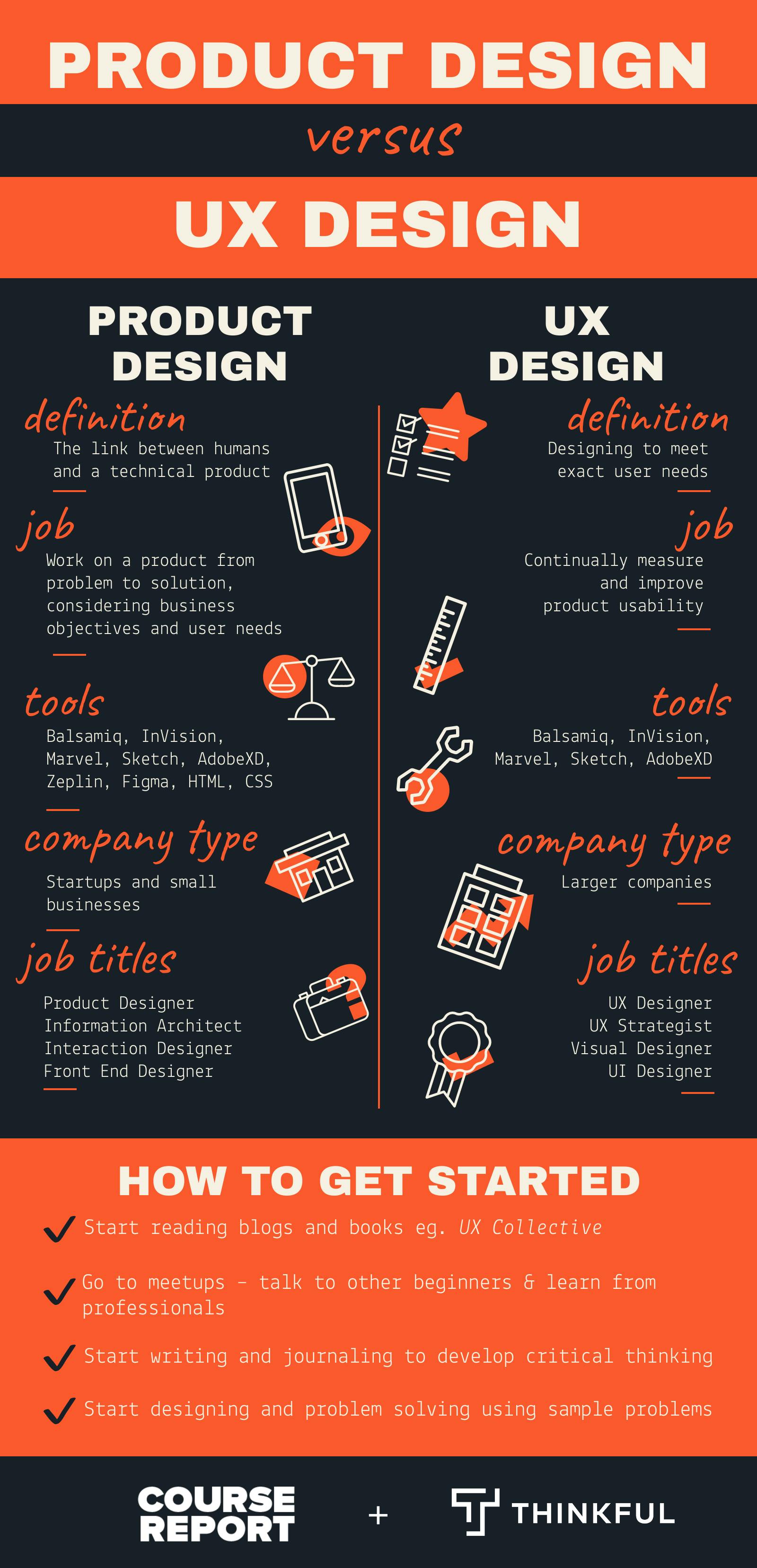Article
Product Design vs UX Design
![]()
Written By Imogen Crispe
![]()
Written By Imogen Crispe
Course Report strives to create the most trust-worthy content about coding bootcamps. Read more about Course Report’s Editorial Policy and How We Make Money.
Course Report strives to create the most trust-worthy content about coding bootcamps. Read more about Course Report’s Editorial Policy and How We Make Money.

Understanding the difference between Product Design and UX Design can be challenging since many of the required skill sets can overlap. Terry Million, Design Product Manager at Thinkful, breaks down the two disciplines for us and the potential career opportunities for each. Learn which technical and soft skills are needed for UX vs Product Design, how these roles interact with each other in the real world, and the benefits of understanding both product and UX design for long-term career growth.
This topic is hotly debated – there’s no clear consensus on what product design is versus user experience (UX) design and how they overlap. The titles “product designer” and “UX designer” can be confusing even within our own design industry, and the roles are often used interchangeably from company to company depending on their size, the products they’re delivering, their user needs, and even the company culture.
From a high level, product design is the link between humans and a technical product and UX design is meeting the exact user needs. As the industry and these roles continue to mature, we’re gaining a better understanding of the delineation between them.
The term “product design” has been around a lot longer than UX design but it’s seen a recent spike in popularity with the rapid emergence of digital products over the last decade. Originally, product design was associated with hardware or designing physical products, and the designers were called “industrial designers” (check out the Thinkful blog for more details of that evolution).
Today, the term “product designers” is usually referring to designers working on digital products. Their work is more generalized, it covers the end-to-end experience, and they’re often considered to be highly-skilled generalists (a jack-of-all-trades) that understand and can implement the principles of UX design, visual design, and even front-end design at times. Their main job is to work on a product from problem to solution while considering both the business objectives at play and the user needs to be met.
In the digital context, product designers:
A UX designer’s main goal is to continually measure and improve the usability of a product for its users by leveraging various research methods to better understand those users and their pain points. Much of their work is guided by design thinking – basically a human-centered approach to research – and this research relies heavily on divergent and convergent thinking, which helps identify those needs and provides a way to ideate and test the best ways to serve those particular needs.
UX designers:
A company usually will have one or the other serving in a very similar role. If the team is big enough to staff both roles, a UX designer will handle the research and testing efforts of the design process, while the product designers will take the research and data and analyze, synthesize, and strategize how to best implement the solution to serve the business objectives and user needs.
Both roles use similar design software to prototype and design their software.
In addition, product designers also use tools with developer hand-off capabilities: Zeplin, Figma, or directly code interactive prototypes in HTML or CSS.
Now we’re really talking about a hotly debated topic! That depends on our definition of “how to code.” If we’re talking about writing production-level code from scratch, it’s highly unlikely but not unheard of – a smaller company may require it. As these roles continue to mature, our research shows that UX designers are less likely to be coding on the job, but the product designer may, even without employer expectations.
For aspiring designers, HTML and CSS are just as much of a design tool as Sketch and Figma and it really isn’t like programming in Javascript. HTML is a markup language, it’s used to structure content. CSS is used to style the content – it’s basically the same as dropping content in your favorite design application and making it look the way you want. Designers who know the capabilities and limitations of code can make sure their designs are feasible both from a functionality and implementation perspective, as well as a cost perspective. By learning the ins and outs of code or HTML/CSS, it will help them collaborate with developers who are building out their products.
People tend to think a designer’s most important soft skill is creativity, and while it has its rightful place in design, it’s not the only soft skill a designer needs to be successful. These skills are important for product designers and UX designers:
Startups and small businesses often need more cross-functional skill sets from their employees. They’ll employ a UX or UI designer to handle a lot of the responsibilities we’ve come to expect from a product designer, mainly to get more impact out of a smaller team. Larger companies are more specific in their job descriptions, don’t require that cross-functionality, and often have very explicit roles for the disciplines within product design, breaking out among UX, visual, and front end design. Product designers also serve as design leads or senior designers, given their understanding of design’s business value. For example, Facebook has product designers that work with UX researchers, so their delineation is that the UX designers are doing the user research.
If you look at the entire product lifecycle, there are different specializations within Product Design and UX Design:
Having a generalist perspective of that process opens up opportunities to become more specialized in the long-run. A lot of our Thinkful students come in with marketing or product management backgrounds, so their adjacent skills supplement their learning. Most of our students go on to become either a Product Designer or UX Designer, but becoming generalists affords them the ability to focus their career on their area of interest. Other students have gone on to specialize as UX Researchers, Interaction Designers, and Product Managers.
They’re both hard in their own right and are very process-driven, but understanding the formula structure doesn’t guarantee you’ll be able to implement that process and deliver a viable solution. That’s the challenge and both are time-intensive to become successful – it takes time to learn and do it, either in a bootcamp or on the job. Between the two, it would probably take longer to learn product design versus UX design given all the skills involved, and the number of topics and disciplines within the product lifecycle.
UX design could be a more siloed view that hyper focuses on the user portion of the product, whereas product design takes a more holistic view of the entire process and all the stakeholders involved – not just the end-user but the client as well. Having that more generalized skill set could help you understand what areas of product development you are most interested in.
Our approach to Product Design does not exclude teaching UX Design. UX design makes up roughly a third of the program and is covered in our UX Fundamentals module, our UX Intensive module, and in each of the students’ projects. We’ve designed this program to create product design generalists, providing the flexibility for students to gain exposure into all three major disciplines of product design, opening the door to a lot of different career roles. They work with their mentor to ensure the projects they’re completing best position them for the job they inevitably want. Employers look for that generalist understanding and cross-functional skill set.
It is focused on the three major disciplines – UX design, visual design, and front end design.
If you’re interested in the business aspects as well as the design aspects of product development, then product design is probably a good choice. Understanding the business also can push a designer into more senior roles. If you aren’t passionate about the business details and would rather focus on solving problems and user interactions, than UX is a better fit.
Either way, you’re problem solving, you just have to decide which problems you want to work on – business problems, user problems, or both.
Start reading. There are a ton of smart people writing about UX and product design, especially on Medium. There are a lot of thought leaders, as well as traditional publications and blogs.
Go to meetups. Talk to others in the same situation as you who are just learning, as well as those who have been in the space for a while so you can learn from their successes and failures.
Start writing. We’re really adamant at Thinkful and Bloc about journaling the process. Writing is one of the best ways to begin developing your critical thinking skills which is one of the most important soft skills of being a designer.
Start designing. Design isn’t a skill that you learn by studying, you learn by doing it. Find a problem to solve, talk to the people who are affected and start thinking about the way to solve that problem.
Interested in Thinkful’s Product Design bootcamp? Learn more on the Thinkful website and read Thinkful reviews.

Imogen Crispe, Content Creator and Entrepreneur
Imogen is a writer and content producer who loves exploring technology and education in her work. Her strong background in journalism, writing for newspapers and news websites, makes her a contributor with professionalism and integrity.










Sign up for our newsletter and receive our free guide to paying for a bootcamp.
Just tell us who you are and what you’re searching for, we’ll handle the rest.
Match Me